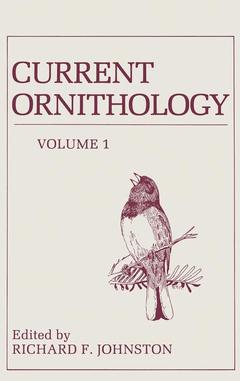Description
Current Ornithology, 1983
Current Ornithology Series, Vol. 351
Coordinator: Johnston Richard
Language: English
Publication date: 04-2013
425 p. · 15.2x22.9 cm · Paperback
425 p. · 15.2x22.9 cm · Paperback
Description
/li>Contents
/li>
The appearance of the first volume of a projected series is the occasion for comment on scope, aims, and genesis of the work. The scope of Current Ornithology is all of the biology of birds. Ornithology, as a whole-organism science, is concerned with birds at every level of bi ological organization, from the molecular to the community, at least from the Jurassic to the present time, and over every scholarly discipline in which bird biology is done; to say this is merely to expand a dic tionary definition of "ornithology. " The aim of the work, to be realized over several volumes, is to present reviews or position statements con cerning the active fields of ornithological research. The reviews will be relatively short, and often will be done from the viewpoint of a readily identified group or school. Such a work could have come into being at any time within the past fifty years, but that Current Ornithology appears now is a result of events that are only seven to eight years old. One important event was the initiation in 1975-1976 of the Workshop on a National Plan for Ornithology, under the directorship of James R. King and Walter J. Bock, cosponsored by the American Ornithologists' Union and the Na tional Science Foundation. Part of the Workshop's interests lay in pub lications resources, and certain kinds of information on publications were obtained by means of a questionnaire.
1 Comparative Avian Demography.- 1. Introduction.- 2. Phenomenology and Hypotheses.- 3. Demographic Evolution.- 4. Density Dependence.- 5. Demographic Evolution in Varying Environments.- 6. Correlated Environmental Factors.- 7. Discussion.- References.- 2 The Determination of Clutch Size in Precocial Birds.- 1. Introduction.- 2. Precocial Development.- 3. Clutch Size Theory and Terminology.- 4. Patterns in Clutch Size Variation.- 5. Factors Limiting Clutch Size.- 6. Discussion.- 7. Conclusions.- References.- 3 Structure and Function of Avian Eggs.- 1. Introduction.- 2. Mass and Contents of Eggs.- 3. Gas Exchange.- 4. Gas Exchange and the Eggshell.- 5. Summary.- References.- 4 The Origin of Birds and of Avian Flight.- 1. Introduction.- 2. The Nature of Archaeopteryx.- 3. The Origin of Birds.- 4. The Origin of Avian Flight.- 5. Conclusions.- References.- 5 The Great Plains Hybrid Zones.- 1. Introduction.- 2. Accounts of Hybridizing Taxa.- 3. Discussion.- References.- 6 Species Concepts and Speciation Analysis.- 1. Introduction.- 2. Species Concepts.- 3. Speciation Analysis.- References.- 7 Bird Chromosomes.- 1. Introduction.- 2. The Diploid Number Problem.- 3. Differential Banding Procedures.- 4. Concluding Remarks.- References.- 8 Genetic Structure and Avian Systematics.- 1. Introduction.- 2. Methods of Data Acquisition and Analysis.- 3. Genetic Data and Their Role in Systematics.- 4. Conclusions.- References.- 9 Phylogeny and Classification of Birds Based on the Data of DNA-DNA Hybridization.- 1. Introduction.- 2. The DNA-DNA Hybridization Technique.- 3. The Analysis of DNA-DNA Hybridization Data.- 4. Homology.- 5. The Evolution of DNA.- 6. The Calibration Problem.- 7. Adaptive Radiation.- 8. Categorical Equivalence.- 9. Classification.- References.- 10 Experimental Analysis of Avian Limb Morphogenesis.- 1. Introduction.- 2. Mapping the Prospective Skeletal Areas.- 3. Regulation along Proximo-distal and Antero-posterior Axes.- 4. The ZPA and Experimental Analysis of Control of Antero-posterior Differentiation of the Wing.- 5. Somite and Limb Bud Developmental Relations.- 6. Innervation and Limb Development.- 7. Conclusions.- References.- 11 Variation in Mate Fidelity in Monogamous Birds.- 1. Introduction.- 2. Which Birds Are Monogamous?.- 3. Types of Variations in Mate Fidelity.- 4. Opportunistic and Facultative Polygyny.- 5. Polyandry.- 6. Conclusion.- References.- 12 The Evolution of Differential Bird Migration.- 1. Introduction.- 2. Winter Distribution of Eastern Migratory Juncos.- 3. Single-Factor Hypotheses for the Evolution of Differential Migration.- 4. A Multifactor Hypothesis for the Evolution of Differential Migration.- 5. Conclusions.- References.- Author Index.- Bird Name Index.
© 2024 LAVOISIER S.A.S.
These books may interest you

Current Ornithology 52.74 €

Current OrnithologyVolume 3 52.74 €

Current Ornithology 52.74 €


